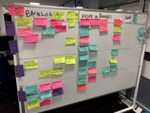We need to talk about TOM
Most people go their whole lives without encountering a Target Operating Model (TOM). If you are one of the unlucky few who have to work on a TOM this post provides some hints and tips. I hope it will help you survive the experience and even get something useful out of it. Enormous amounts of money and energy go into TOMs so we should get more value out than we put in.












